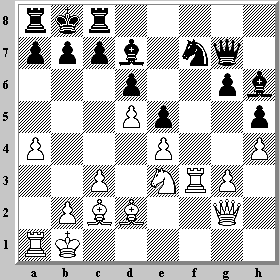After 22 moves, the players had developed all of their minor pieces, brought their Queens into play, and were ready to castle. The 'RKR' placement of the start position is still visible in the Black pieces.
Mainz 2007, Final Match, Game 2
Aronian, Levon
Anand, Viswanathan
(After 22...Bb5-d7)
[FEN "rkr5/pppb1nq1/3p2pb/3Pp2p/P3P2P/2P1NRP1/1PBB2Q1/RK6 w Aca - 0 23"]
White can castle O-O-O immediately, while Black, before castling ...O-O-O, needs to move the Rook on c8 to any square except d8. Black does, however, have another immediate possibility.
The next moves were 23.O-O-O O-O(!). Black's last move, castling ...O-O, shows the King and Rook making the longest possible castling move in chess960. It might easily be overlooked in the diagrammed position.
After castling, White's King and Rook were on c1 and d1, while Black's were on g8 and f8. With the next moves, 24.Rdf1 Rae8, both players brought the last undeveloped Rook into the game. The full score, courtesy of Chess Tigers, is
[Event "FiNet Chess960 Rapid World Championship"]
[Site "Chess Classic Mainz"]
[Date "2007/8/16"]
[Round "8"]
[White "Anand"]
[Black "Aronian"]
[Result "1/2-1/2"]
[SetUp "1"]
[FEN "rkrbbnqn/pppppppp/8/8/8/8/PPPPPPPP/RKRBBNQN w CAca - 0 1"]
1.e4 e5 2.Ne3 Ne6 3.Ng3 d6 4.c3 Ng6 5.d3 Ngf4 6.Bc2 g6 7.Rd1 Qg7 8.Ngf1 Nc5 9.g3 Nfe6 10.Nd2 Bg5 11.f3 f5 12.Ndc4 fxe4 13.fxe4 h5 14.h4 Bh6 15. d4 Nd7 16.d5 Nd8 17.Bd2 Nf6 18.Rf1 Bb5 19.Rf3 Ng4 20.Qg2 Nf7 21.a4 Nxe3 22.Nxe3 Bd7 23.O-O-O O-O 24.Rdf1 Rae8 25.b3 Nd8 26.Bd3 Rxf3 27.Rxf3 Rf8 28.Rxf8+ Qxf8 29.a5 b6 30.a6 Nf7 31.Qf1 Qe7 32.Nc2 Bxd2+ 33.Kxd2 Qe8 34. Qf6 Nh6 35.Be2 Kh7 36.Nb4 Ng8 37.Qg5 Qf8 38.Ke1 Qe7 39.Qxe7+ Nxe7 40.Nc2 Kh6 41.Na3 g5 42.Bb5 Bc8 43.Kf2 Ng6 44.Nc2 gxh4 45.gxh4 Ne7 46.Nb4 Kg7 47.Be8 Bg4 48.Na2 Bc8 49.Bb5 Ng8 50.Nb4 Ne7 51.Be2 Kg6 52.Nc2 Ng8 53.b4 Nf6 54.Ke3 Kf7 55.Bb5 Ke7 56.Bd3 Bd7 57.b5 Kf7 58.c4 Kg6 59.Nb4 Ng8 60. Bf1 Ne7 61.Be2 Kh6 62.Kf2 Kg6 63.Kg3 Kh6 64.Nc2 Kg6 65.Ne3 Ng8 66.Bf3 Nf6 67.Nc2 Be8 68.Bg2 Kg7 69.Kf2 Bd7 70.Kg3 Be8 71.Kf2 Bd7 1/2-1/2
Why did Aronian prefer castling ...O-O over ...O-O-O? That would be a good question for the grandmaster himself.

No comments:
Post a Comment